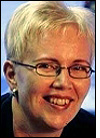Finnish drug manufacturer Orion Pharma and packaging company Stora Enso have concluded their trial of a mixed RFID technology designed to track and authenticate individual bottles of drugs as they move through an international supply chain. The trial ran from February to April, and its participants believe the technology proved itself.
“The trial gave us experience with the technology,” says Jukka Pietilä, supply chain planning manager at Orion Pharma. “Now we are ready and equipped with enough experience to be able to do item-level RFID tagging.”
According to Orion, the project not only provided a foundation for item-level RFID tagging of its products, but also the potential for using RFID to track raw materials and packaging through the company’s own manufacturing processes.
During the trial (see Orion Pharma Tests Item-Level Tagging), Orion put high-frequency (HF) RFID tags on individual containers of Marevan—an anticoagulant used globally to prevent and treat blood clots—and applied EPC Gen 2 UHF RFID tags to cases containing multiple containers. UPM Raflatac supplied both the HF (13.56 MHz) and UHF (868 MHz) tags for the trial.
The goal was to see how viable the technology could be for drug tracking and authentication, as well as for testing both HF and UHF tagging. Reportedly, the results were broadly positive.
“There were no surprises, and everything went as planned, although I was surprised how well HF RFID worked for item-level tagging,” Pietilä recalls, adding that RFID has a number of advantages, such as non-line-of-sight reading, when compared with 2-D bar codes, .
“HF, especially, is mature enough,” says Kirsi Viskari, Stora Enso’s manager of smart packaging. “The HF tags endured the packing line well, and all parties were surprised at how easy to use and reliable the technology was.”
Stora Enso provided its PackAgent application (see Papermaker Works on Brand Authentication) to authenticate tagged shipments from Orion Pharma, through two wholesalers and on to seven retail pharmacies. One wholesaler and four pharmacies were in Finland, while the other wholesaler and pharmacies were in Estonia.
Cases were also labeled with bar codes to be utilized at three places in the supply chain where UHF readers could not be used. The problem, according to Stora Enso, was that these read points required Gen 2-compliant handheld readers, but no such readers were available when the trial began..
“One key lesson learned from the trial was that it is easy to deploy item-level tagging with HF, as the short read range is really appropriate for use in the pharmacy, and especially at the point of sale,” says Viskari.
The trial experienced no problems reading the UHF tags on the cases, but there were concerns raised about the potential for using UHF with other less RF-friendly packaging. While the equipment was set up for the trial, Orion Pharma also tested UHF tags on cases of different products shipped in blister packs, as well as liquids in plastic bottles. The results with blister packs showed that tag performance varied according to where the tag was applied to the case, Viskari says, as well as how the items in that case were positioned.
The companies maintain that the sample and quantity of products tracked during the trial were too small to draw meaningful conclusions about the potential for improvements in the supply chain from using RFID. They agree, however, that RFID is a viable technology.
Orion says it will take what it learned from the trial to draw up an RFID roadmap for itself. The company is convinced that some time in the future, it will have to start applying RFID tags to individual products. “We have to be ready for item-level tagging in the U.S. market,” says Pietilä. “It isn’t required yet, but it will be.”
Stora Enso’s PackAgent application is part of the packaging solutions the company offers its customers (see Papermaker Works on Brand Authentication). The software is compatible with other ID technologies besides RFID. Having completed the trial, Stora Enso says it is ready to begin marketing the application.


